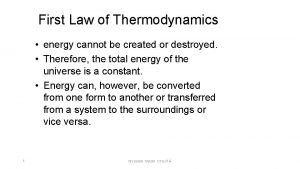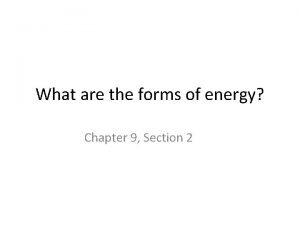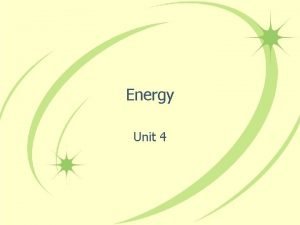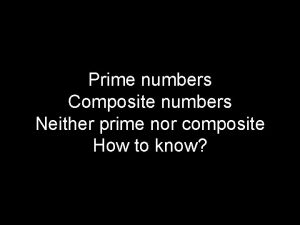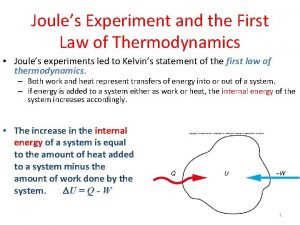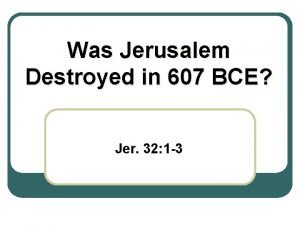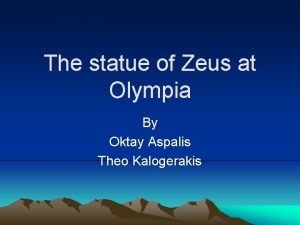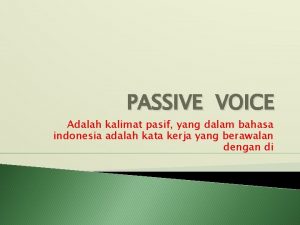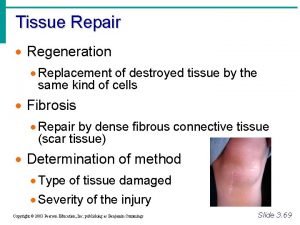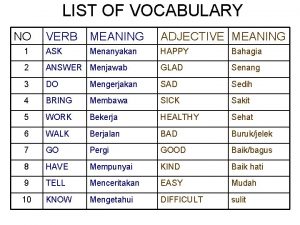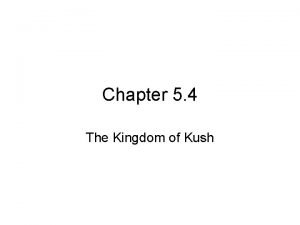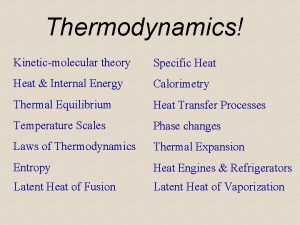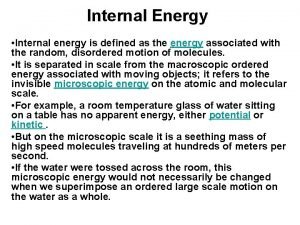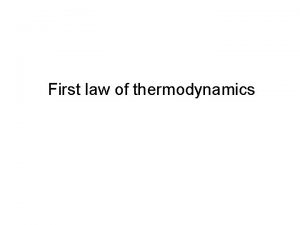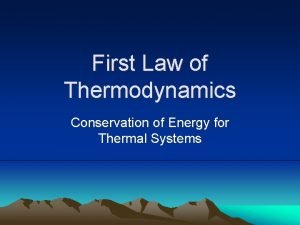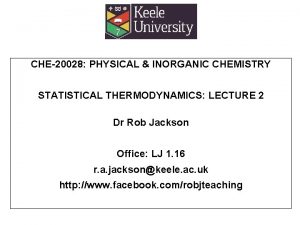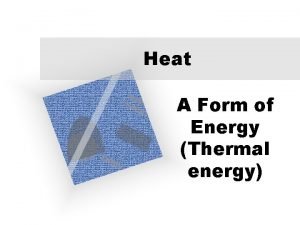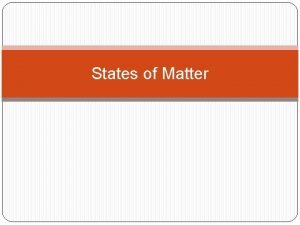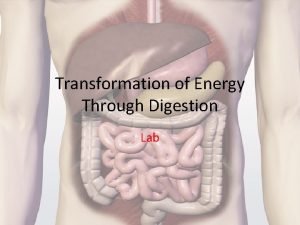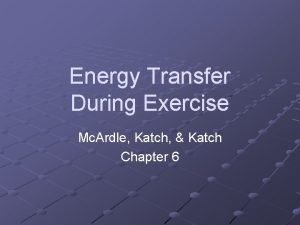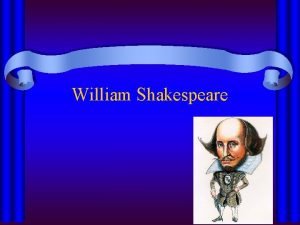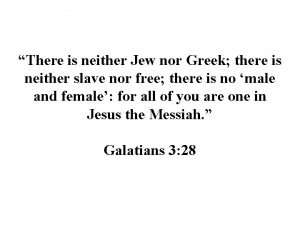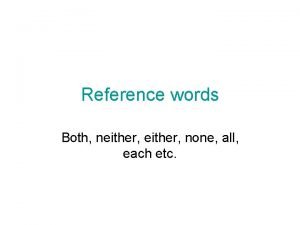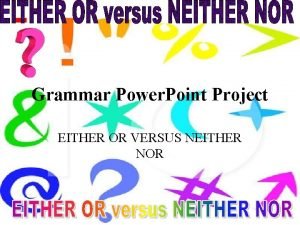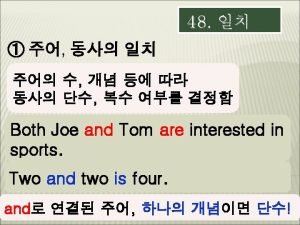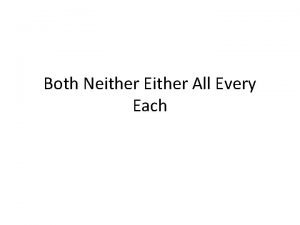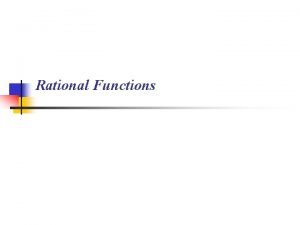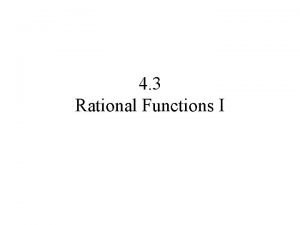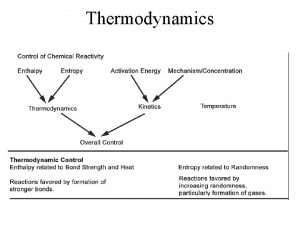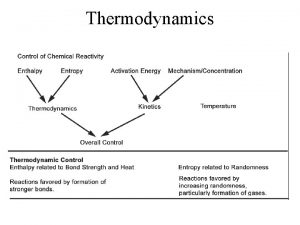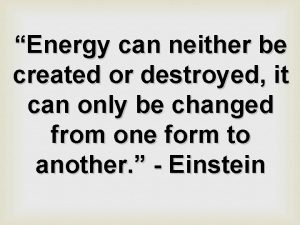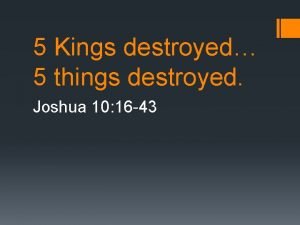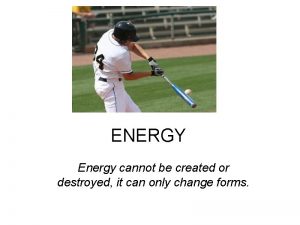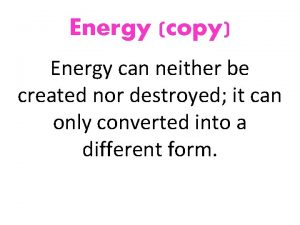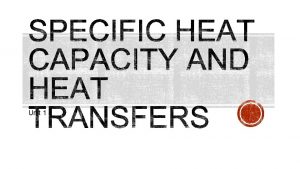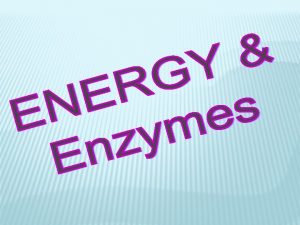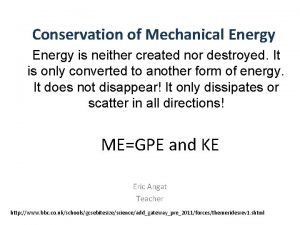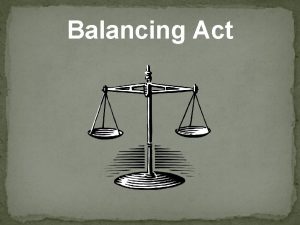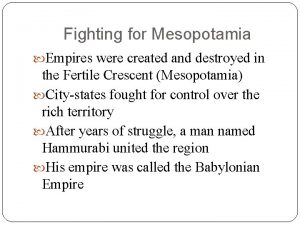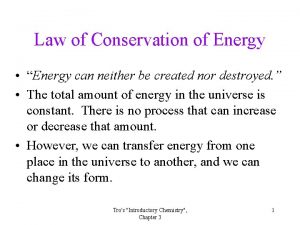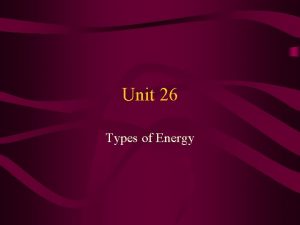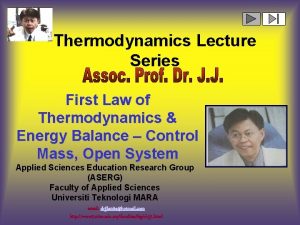Thermodynamics Energy is neither created or destroyed during







































- Slides: 39

Thermodynamics

Energy is neither created or destroyed during chemical or physical changes, but it is transformed from one form to another. Euniverse = 0

TYPES of ENERGY Kinetic Mechanical Thermal Electrical Radiant Energy Conversion Examples: 1. dropping a rock 2. using a flashlight 3. driving a car Potential Gravitational Electrostatic Chemical


SYSTEMS and SURROUNDINGS System: The thing under study Surroundings: Everything else in the universe Energy transfer between system and surroundings: Endo: heat added to system Exo: heat released by system

HEAT: What happens to thermal (heat) energy? Three possibilities: • Warms another object • Causes a change of state • Is used in an endothermic reaction

Temperature Changes from Heat Exchange Example 1: 5 g wood at 0 o. C Example 2: 10 g wood at 0 o. C Example 3: 5 g copper at 0 o. C Example 4: 5 g wood at 0 o. C Choices: 1: 0 o. C 2: 33 o. C 3: 50 o. C + + 5 g wood at 100 o. C 5 g copper at 100 o. C 4. 67 o. C 5: 100 o. C 6: other

What happens to thermal (heat) energy? When objects of different temperature meet: • Warmer object cools • Cooler object warms • Thermal energy is transferred • qwarmer = -qcooler

Quantitative: Calculating Heat Exchange: Specific Heat Capacity

Specific Heat Capacity The energy required to heat one gram of a substance by 1 o. C. Usefulness: #J transferred = S. H. x #g x T How much energy is used to heat 250 g water from 17 o. C to 100 o. C?


What happens to thermal (heat) energy? When objects of different temperature meet: • Warmer object cools • Cooler object warms • Thermal energy is transferred • qwarmer = -qcooler specific heat x mass x T = specific heat x mass x T warmer object cooler object

Heat transfer between substances: Specific heats: Cu = 0. 385 J/g o. C Wood = 1. 8 J/g o. C

Conceptually Easy Example with Annoying Algebra: If we mix 250 g H 2 O at 95 o. C with 50 g H 2 O at 5 o. C, what will the final temperature be?

Thermal Energy and Phase Changes First: What happens?

Thermal Energy and Phase Changes First: What happens?

Thermal Energy and Phase Changes First: What happens?

But what’s really happening? Warming: • Molecules move more rapidly • Kinetic Energy increases • Temperature increases Melting/Boiling: • Molecules do NOT move more rapidly • Temperature remains constant • Intermolecular bonds are broken • Chemical potential energy (enthalpy) increases

Energy and Phase Changes: Quantitative Treatment Melting: Heat of Fusion (DHfus) for Water: 333 J/g Boiling: Heat of Vaporization (DHvap) for Water: 2256 J/g

Total Quantitative Analysis Convert 40. 0 g of ice at – 30 o. C to steam at 125 o. C Warm ice: (Specific heat = 2. 06 J/g-o. C) Melt ice: Warm water (s. h. = 4. 18 J/g-o. C)

Total Quantitative Analysis Convert 40. 0 g of ice at – 30 o. C to steam at 125 o. C Boil water: Warm steam (s. h. = 1. 92 J/g-o. C)

Energy and Chemical Reactions Lots of different types of energy. We use Enthalpy: Heat exchanged under constant pressure.

Energy/Enthalpy Diagrams

Some Examples of Enthalpy Change 2 C(s) + 2 H 2(g) C 2 H 4(g) H = +52 k. J

Enthalpy Change and Chemical Reactions H is usually more complicated, due to solvent and solid interactions. So, we measure H experimentally. Calorimetry Run reaction in a way that the heat exchanged can be measured. Use a “calorimeter. ”


Bomb Calorimetry Experiment N 2 H 4 + 3 O 2 2 NO 2 + 2 H 2 O Energy released = E absorbed by water + E absorbed by calorimeter Ewater = Ecalorimeter = Total E = H = energy/moles = 0. 500 g N 2 H 4 600 g water 420 J/o. C

Enthalpy Change and Bond Energies H = energy needed to break bonds – energy released forming bonds Example: formation of water: H = [498 + (2 x 436)] – [4 x 436] k. J = -482 k. J

General Rule:


SO 2 + ½ O 2 SO 3 d. H = -98. 9 k. J 2 SO 3 2 SO 2 + O 2 d. H = ?

Hess’s Law Enthalpy is a State Function.

Thermochemistry Lab Calculations Goal: What is H for the formation of Mg. O from Mg(s) and O 2(g)? Mg(s) + ½ O 2(g) Mg. O(s) Data: From lab measurements: H = ? k. J/mol Mg(s) + 2 H+(aq) Mg 2+(aq) + H 2(g) H 1 = ______ k. J/mol Mg. O(s) + 2 H+(aq) Mg 2+(aq) + H 2 O(l) H 2 = ______ k. J/mol From a table: H 2(g) + ½ O 2(g) H 2 O(l) H 3 = -285. 8 k. J/mol Task: Find a way to add these three reactions to get the desired reaction. Manipulate the H values as needed, and add them.

Calculating Heat Production

Heat of Formation


Heat of Formation: The general idea


Find the enthalpy change for burning ethyl alcohol
 Energy cannot be created or destroyed
Energy cannot be created or destroyed Energy can be created and destroyed
Energy can be created and destroyed In a wild shot bo flings a pool ball of mass m
In a wild shot bo flings a pool ball of mass m The number which is neither prime nor composite is
The number which is neither prime nor composite is The joule experiment
The joule experiment Was jerusalem destroyed in 607 bce
Was jerusalem destroyed in 607 bce Giant statue of zeus
Giant statue of zeus Mr deni teaches computer every saturday
Mr deni teaches computer every saturday Replacement of destroyed tissue by the same kind of cells
Replacement of destroyed tissue by the same kind of cells Which parts of tohirin’s house were destroyed?
Which parts of tohirin’s house were destroyed? Verb 3 repair
Verb 3 repair Presuppositionalism destroyed
Presuppositionalism destroyed Where did the kushites settle
Where did the kushites settle Entropy equation temperature
Entropy equation temperature Steady flow energy equation thermodynamics
Steady flow energy equation thermodynamics Internal energy in thermodynamics definition
Internal energy in thermodynamics definition Laws in thermodynamics
Laws in thermodynamics First law of energy conservation
First law of energy conservation Internal energy formula
Internal energy formula Formula formula
Formula formula Energy energy transfer and general energy analysis
Energy energy transfer and general energy analysis Energy energy transfer and general energy analysis
Energy energy transfer and general energy analysis How is thermal energy created
How is thermal energy created Food digestion energy transformation
Food digestion energy transformation Energy transfer during exercise
Energy transfer during exercise During conduction, thermal energy is transferred
During conduction, thermal energy is transferred Neither a borrower nor a lender be quote
Neither a borrower nor a lender be quote No greek nor jew
No greek nor jew You need a new winter coat tag questions
You need a new winter coat tag questions Subject verb agreement exercise
Subject verb agreement exercise All both neither none either
All both neither none either Parallel structure with paired conjunctions
Parallel structure with paired conjunctions Neither so
Neither so Either or vs neither nor
Either or vs neither nor A or b?
A or b? Either both or neither of x and y should be given
Either both or neither of x and y should be given How to find the vertical asymptote of a rational function
How to find the vertical asymptote of a rational function Unit 4 linear equations
Unit 4 linear equations Inversion with neither nor
Inversion with neither nor Rational fucntion
Rational fucntion
